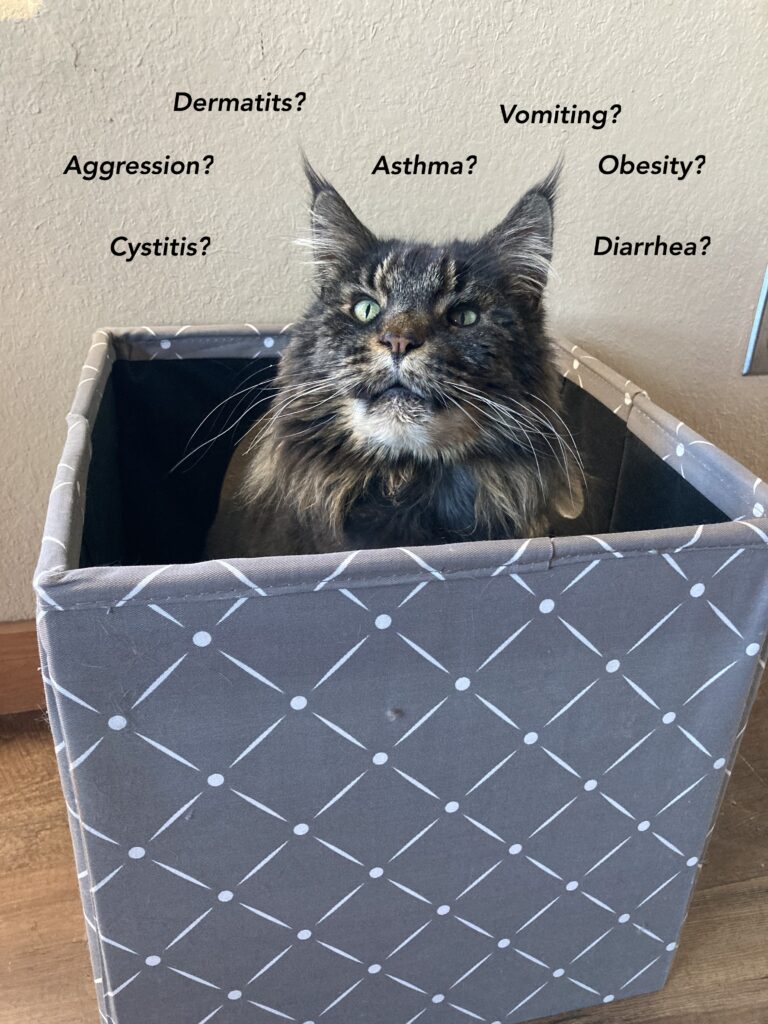
The term “Pandora syndrome” was coined by Tony Buffington of Ohio State University to describe cats with chronic clinical symptoms suffering from health issues involving multiple organ systems. Buffington initially studied a group of 200 cats that had “incurable” urinary tract symptoms (bloody urine, difficulty urinating, urinating outside the box, and urinating small amounts). These cats had other health issues in addition to the urinary tract disease. Curiously enough, the cats’ symptoms resolved after living in an enriched environment (Reference 1).
Early studies linked the urinary symptoms to diets containing too much magnesium, causing formation of urinary stones. However, dietary changes did not resolve the cats’ urinary issues and they continued to suffer from bloody urine, difficulty urinating, urinating outside the box, and urinating small amounts, frequently in the absence of stones (Reference 1).
diagnosing Pandora Syndrome in cats
What “Pandora Cats” have in common (Reference 2):
- history of traumatic experiences such as abandonment, orphaning, infection
- having more than one disease at once
- clinical symptoms that wax and wane in response to changes in the environment
More About Pandora syndrome in cats
Genetic makeup and traumatic events are thought to contribute to Pandora syndrome in cats. Our genomes (cats and humans) contains the DNA that makes us unique. DNA is made up of 4 building blocks that can be assembled in different orders. The sequence of the DNA building blocks in a gene provides the code for a particular trait such as eye or hair color (Reference 3).
However, there is more to growth and development than just genes that code for a particular trait. The science of epigenetics studies modifications to our DNA that don’t change the order of the DNA building blocks. The epigenome refers to chemical compounds that are attached to your DNA. Exposure to pollutants, what you eat, and stress are some things that can result in certain molecules attaching to your DNA and turning particular genes on or off. This is why genetically identical twins may have different skills, health, or behavior (Reference 3).
The epigenome is reset when the genome is passed on from parents to their offspring at conception. Maternal stress during pregnancy, traumatic events such as abandonment, orphaning, and infection can subsequently affect the epigenome. While many cats recover from these things, others may develop chronic illnesses or behavioral abnormalities (Reference 2).
Pandora cats are inherently “sensitive” cats who have difficulty coping with challenges presented by their environment. They have a heightened stress response that increases the likelihood of them becoming ill.
Why the name “Pandora” syndrome?
Pandora is a figure from Greek mythology. She was a human woman made by the gods from clay. She was endowed with many attributes, such as beauty, charm, cleverness, and curiosity. Before sending her to earth, the gods gave her a box, that she was told NEVER to open. Pandora’s curiosity got the best of her one day and she opened the box, releasing evils to plague mankind – disease, violence, greed, old age, death… However, all was not lost. Hope was also in the box to help people survive and cope with the evils in the world.
Like Pandora’s box, “Pandora cats” have multiple problems (“evils”).
diagnosing pandora syndrome in cats
A diagnosis of Pandora Syndrome is a diagnosis of exclusion – the symptoms may respond to medical therapies but then recur. Diagnostic procedures do not reveal a root cause. Diagnosis requires an extensive review of the cat’s life history, medical history and home environment. Some sample questions are below. (A more complete history form can be found in the supplementary materials of Reference 2).
Life History
- where did the cat come from? from a shelter? was he/she a stray? an orphan?
- are other cats/pets in the house?
- how many people in the house?
- indoor only? outdoor access?
- is your cat fearful? friendly?
Medical History
- vomiting? diarrhea? coughing? sneezing?
- using litter box?
- history of medical problems- e.g. allergies, heart problems?
Environmental Resources
- safe and secure resting places?
- multiple, separated litter boxes, feeding stations, water bowls?
- can the cat interact with people and other pets on his/her own terms?
treating pandora syndrome in cats
Pandora syndrome is treated with medical therapies and MEMO (multimodal environmental modification). MEMO aims to reduce the cat’s perception of threat and increase his/her perception of control of his/her environment. There is no cure for Pandora syndrome but medical therapies and MEMO can reduce the cat’s clinical signs and increase the time between episodes of symptoms (Reference 1).
The goal of MEMO is to create an OPTIMAL environment for the individual cat. This will be the subject of the next post.
references
- C.A. Buffington DVM, PhD, DACVN. Pandora Syndrome in Cats: Diagnosis and Treatment; Today’s Veterinary Practice. August 10, 2018, Issue: September/October 2018. viewed on 1/06/24 https://todaysveterinarypractice.com/urology-renal-medicine/pandora-syndrome-in-cats/
- Tony Buffington CA, Westropp JL, Chew DJ. From FUS to Pandora syndrome: Where are we, how did we get here, and where to now? Journal of Feline Medicine and Surgery. 2014;16(5):385-394. doi:10.1177/1098612X14530212
- National Human Genome Research Institute; Epigenomics fact sheet 8/16/20. Viewed on 1/6/24. https://www.genome.gov/about-genomics/fact-sheets/Epigenomics-Fact-Sheet.
Want to keep up with the world of cats? Subscribe to The Feline Purrspective!

